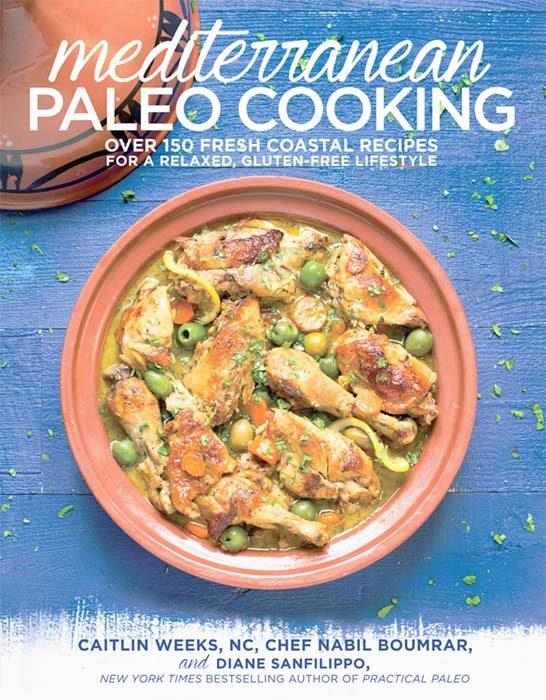
The Paleo concept, she says, is based on eating only foods “that are pre-agriculture, primarily in their whole form, and not eating all these refined foods. This is grounded in evolution and human biology.”
Sanfilippo, author of "The 21-Day Sugar Detox," is most recently co-author, with Caitlin Weeks and Nabil Boumrar, of "Mediterranean Paleo Cooking."
The Paleolithic Era lasted a very long time. Scientists divide it into three sub-eras, beginning about two million years ago and ending in the range of 40,000 to 10,000 years ago. The Paleolithic Era is also known as the Stone Age, because that’s when early humans began using stone tools.
“The Paleo way of eating is not a replication of the caveman diet,” writes Sanfilippo. “It’s just stripped down to eat the way people did before grocery stores existed.”
It’s not a good idea to take Sanfilippo’s flip pronouncements too literally. Eating "pre-grocery store" is a lot different than eating "pre-agriculture." But the basic tenets of a 21st century Paleo diet, she says, involve eating only whole, unrefined foods “as provided by nature.” For Sanfilippo that means avoiding "processed" ingredients like grains, soy, pasteurized dairy, seed oils like corn and canola, and artificial or refined sugar and sweeteners.
“If it has to pass through a factory before it is edible for you," she says, "reconsider whether or not it is actually food."
The fact that Paleolithic humans had a lifespan of only about 30 years is not a knock on their diet, as Sanfilippo sees it. After all, she notes, infant mortality rates were high, and exposure to harsh weather, violent storms, predatory animals, wounds, injuries and infectious diseases in a time before medicine, to say nothing of central heating, made life pretty tough all around.
Early humans simply did not live long enough to develop diseases like cancer and dementia, but their simpler diet, Sanfilippo says, might have protected them from modern scourges like diabetes, which result from too much of a good thing.
Sanfilippo, 36, became a Paleo advocate after years of struggling with weight gain, digestive and dental issues, sinus infections and acne. She began to change her diet, and in time began to lose weight and improve her health. She earned a certificate as a nutrition consultant from Bauman College in Berkeley, California.
She went into business and began giving nutrition seminars. When she found herself answering the same questions over and over, she decided to write her first book, 2012’s "Practical Paleo: A Customized Approach to Health and a Whole-Foods Lifestyle."
“If you had heard about the Paleo diet, you could get this book,” she says. "You would have the background information and you’d also have the recipes to go ahead and do it.”
In terms of individual health, she stresses the importance of listening to your digestive system. “If your body constantly suffers from digestive irritation, you set the stage for suppressed immune function in all other areas.”
Additionally, the balance of protein, fat and "good carbs," like yams and carrots, she says, will help regulate blood sugar and not leave you constantly hungry.
Paleo nutrition includes foods made with organic meats, seafood and eggs, natural fats like grass-fed butter, coconut and palm oils, nuts and seeds, herbs and spices, lots of vegetables and a limited amount of fruit. Organ meats, sea vegetables, homemade bone broths and fermented ingredients like yogurt and kefir she considers “superfoods,” for their density of vitamins A, D, omega 3 fatty acids, calcium, magnesium and iodine.
Sanfilippo’s books are full of information, inspiration and easy recipes, like blueberry lemon muffins made with coconut flour and maple syrup; lettuce-wrapped skirt steak tacos; Greek lamb kabobs; and honey-sweetened pistachio mousse.
“You don’t have to rely on factory-derived, packaged calories stamped with unfounded health claims that are nothing more than marketing spin,” Sanfilippo writes. “You can find extraordinary health in beautifully simple, unprocessed, whole foods.”
Blueberry Lemon Muffins
From Practical Paleo by Diane Sanfilippo
6 eggs
½ cup butter or coconut oil, melted
1 teaspoon pure vanilla extract
¼ cup grade B maple syrup
1 lemon, juice and zest
½ cup coconut flour
½ teaspoon sea salt
¼ teaspoon baking soda
1 cup fresh blueberries
Preheat oven to 350°F
Whisk the eggs, butter or coconut oil, pure vanilla extract, maple syrup, lemon juice, and zest together in a large mixing bowl. Sift in the coconut flour, sea salt, and baking soda, and stir until well combined. Gently fold in the blueberries.
In a muffin tin, scoop ¼ cup of batter into each lined muffin cup (natural parchment muffin papers work best for lining), and bake for 35-40 minutes.
Greek-Style Lamb Kabobs
From Practical Paleo by Diane Sanfilippo
1 lb lamb stew meat, cubed
1 bell pepper, cut into 1-inch pieces
2 zucchini, cut into 1-inch pieces
1 red onion, cut into 1-inch pieces
Juice of 2 lemons or limes
½ teaspoon dried oregano
½ teaspoon sea salt
¼- ½ teaspoon black pepper to taste
¼ cup extra-virgin olive oil
Preheat on outdoor or indoor grill to medium-high heat.
Arrange the cubes of lamb on heat-safe skewers, alternating with the bell peppers, zucchini, and onions (or other vegetables).
In a small mixing bowl, combine the lemon or lime juice with the oregano, sea salt, and black pepper. Brush the citrus mixture over the skewers and allow them to marinate for 10 minutes.
Place the skewers onto the grill or grill pan and cook for approximately 3-4 minutes per side or until done to your liking. Drizzle the skewers with the extra-virgin olive oil just prior to serving.
SUZANNE ZIMMER LOWERY is a food writer, pastry chef and culinary instructor at a number of New Jersey cooking schools. Find out more about her at suzannelowery.com.

